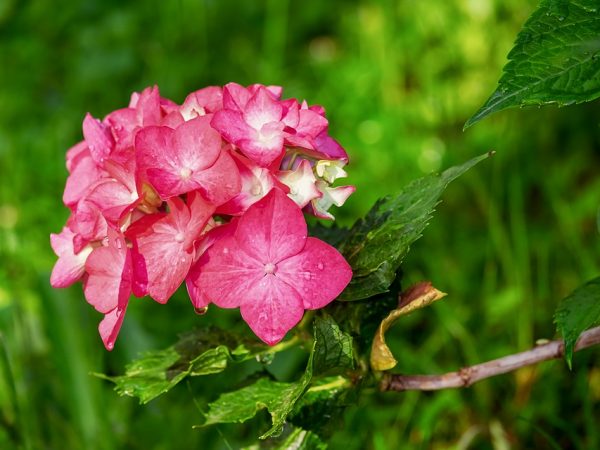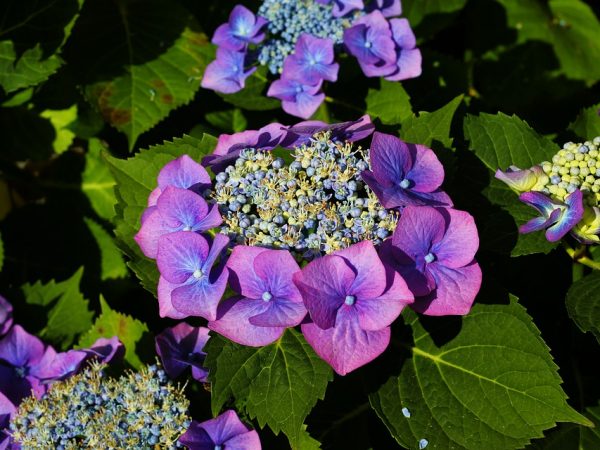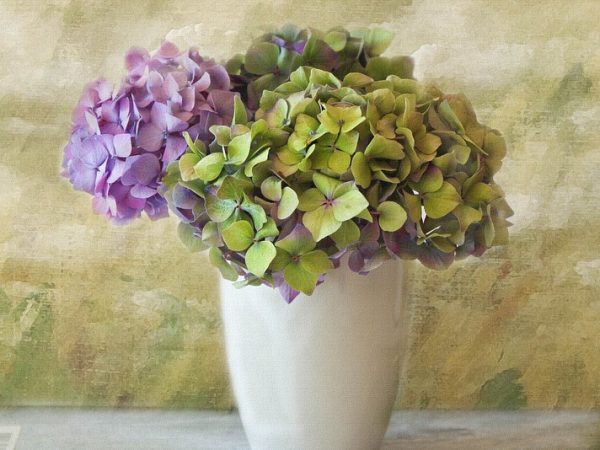Transplanting a room hydrangea - instructions and advice
Transplanting a room hydrangea is a prerequisite for the normal development of a home flower. More often, the procedure is carried out with a lack of space for a growing root system and depletion of the soil. Sometimes - due to the defeat of the disease or the appearance of pests.

Transplanting a room hydrangea
Optimal timing
When growing hydrangeas in the open field, they try to immediately plant it in a permanent place of growth.
And here is the indoor hydrangea (Hydrangea) need to be replanted to improve flowering quality:
- Young - annually, while the substrate is updated and a pot of larger diameter is selected;
- Adult - at least once every 4 years.
- For old flowers, they are limited to replacing the surface layer of the soil mixture to a depth of about 5-7 cm.
The transplant can be carried out both in the spring and in the fall. The procedure is often combined with its reproduction by dividing the bush.
- In the spring - they plan at the very beginning of the season, before the active growth of the plant.
- In autumn - after flowering, at the time of preparation for winter.
An emergency change of capacity and soil is done in any season if the development of infectious diseases is observed or pests living in the soil are massively spreading, which threatens the death of an indoor flower.
Benefits of an autumn transplant
Many growers prefer to transplant in the fall, because the plant gradually adapts to new conditions and transitions to a dormant stage, when no strength is required to grow and build up green mass.
In spring, there is a delay in the beginning of flowering, because initially, the main forces of the flower will be directed to the development of the root system and the development of the empty space of the pot.
The necessary conditions
Ground requirements
Hydrangea at home and in the garden develops well in acidic or slightly acidic clay soils and grows poorly in alkaline sandy soil mixtures.

How to transplant a hydrangea from a pot
The composition of the soil mixture directly affects the color of the inflorescences. In more acidic plants, the plant blooms with blue buds, with less acidity - pink, in neutral - white.
For planting indoor hydrangea, they often use a ready-made substrate developed for growing azaleas and begonias.
You can prepare a soil mixture yourself by mixing turf, leaf humus, coarse sand and peat (3: 3: 2: 1). The soil is oxidized by adding needles, peat mixture or sawdust. For alkalization, wood ash, chalk and lime are used.
Flower pot requirements
The root system of hydrangea is fibrous with a superficial horizontal arrangement. A wide, shallow pot is best suited for growing a flower. Drainage holes should be arranged at the bottom.
For a young seedling, the container is chosen with a diameter of about 9-10 cm. Then it is selected 2-3 cm wider than the previous one.
Too large a container becomes the reason for fattening the plant, which, first of all, in the conditions of free space, will begin to build up the root system and only after full development of the space will it begin to start up fresh shoots.
The most suitable material for a flower pot is clay or ceramics, which have porosity, which ensures air permeability and good evaporation of excess log through the walls. This helps to avoid stagnant water.
When planting in plastic containers, you should pay special attention to the organization of watering. Plastic does not allow water to evaporate, which provokes root rot.
General transplant rules
The first transplant of a houseplant is forced, it is carried out immediately after purchase.

Hydrangea indoor transplant after purchase
The main rule during this period is a thorough examination of the root system for the presence of a mealybug, which often affects the culture. Additionally, the condition of the roots is analyzed: the decayed areas are cut off, and the surviving healthy shoots are pretreated with a weak pink solution of potassium permanganate (potassium permanganate).
The remnants of the temporary soil mixture in which the hydrangea grew are removed by soaking in water for 0.5 hours.
A mandatory requirement for planting a plant is the organization of a drainage layer. Expanded clay is suitable in the form of balls or a crushed mixture.
Transfer method recommended. Technology:
- the soil is dried for 3-4 days;
- the work surface is lined with plastic wrap or paper, the flower pot is placed in the center, tilted and the plant is removed, taking it by the base;
- the remains of an earthen coma on the roots are left without shaking off much;
- drainage with a thickness of 3 or more cm is laid on the bottom, chopped sphagnum or neutral peat can be placed on it;
- the soil is poured with a layer of about 1-2 cm, a flower is placed in the central part and sprinkled with earth mixture to the required level, the root collar is placed flush with the ground, deepening not lower than the distance at which the hydrangea was previously in the substrate, otherwise there is a risk of stem decay;
- the soil is not compacted so as not to damage the closely located root system;
- the plant is sprayed and placed in a permanent place of growth, and the next day it is fully watered;
- the surface of the substrate can be sprinkled with a thin layer of peat mixture to prevent rapid evaporation of moisture.
Care
When grown indoors, indoor hydrangea needs almost the same care as growing outdoors.
Watering
If the leaves of an indoor flower begin to dry and turn brown, these are the first signs of a lack of watering.

How to properly transplant a hydrangea in a pot
Hydrangea requires abundant moisture. It should be watered regularly, as the surface layer of the substrate dries out.
Water is used filtered, warm, room temperature. In order to maintain lush flowering, lemon juice is added - about 5 drops per liter. The presence of lime in the water leads to foliar chlorosis.
In the summer, in addition to watering, they arrange spraying on the leaf. In autumn, the regularity of watering procedures is reduced, in winter they are minimized. And in the spring, when fresh leaves appear on the plant, the regime is restored.
Top dressing
Homemade hydrangea is fed throughout the growing season.
- Primarily - after waking up from a state of rest (approximately in February). Fertilizer complexes with a high nitrogen content are used. This will help stimulate shoot growth and build up green mass.
- In the spring, the plant needs potassium and phosphorus in order to lay a large number of buds.
- In the summer, food is applied three times - with the formation of flower ovaries, at the beginning of the budding process and at the stage of active flowering to bloom the inflorescences.At the beginning of the season, nitrogen fertilizers are needed, and by the end, they increase the proportion of potassium and phosphorus, more often they use a mixture of potassium sulfate (15 g) and superphosphate (20 g), diluted with water (5 l);
- In autumn, for the purpose of the future laying of peduncles and shoots, potassium and phosphorus are used in the form of compost, peat and humus or ready-made nutritional complexes.
The interval between dressings is once every 2 weeks. The method used is root watering.
Useful Tips
A few helpful tips will help you avoid common mistakes and shorten the adaptation period of a houseplant after transplanting.

Indoor hydrangea home care transplant
- In the absence of the need to take emergency measures, it is not worth replanting hydrangea during the flowering stage and in summer.
- When the home hydrangea reaches a large size and there is no suitable pot for it, the bush is divided, seated in different containers.
- To prevent the flower culture from shedding fresh, still unopened buds, you do not need to touch the inflorescences that are gaining strength. For the same reason, until the complete end of budding, drying flowers are not removed.
- The ability of hydrangia to change the color of petals depending on the acidity of the soil is widely used by experienced growers experimenting with the cultivation of unusual compositions. To this end, they apply different fertilizers designed for acidic and alkaline environments, and apply them to the sides of the pot. As a result, the hydrangea bush blooms with buds of different colors.

